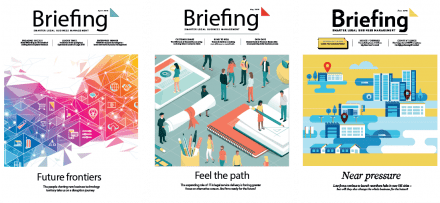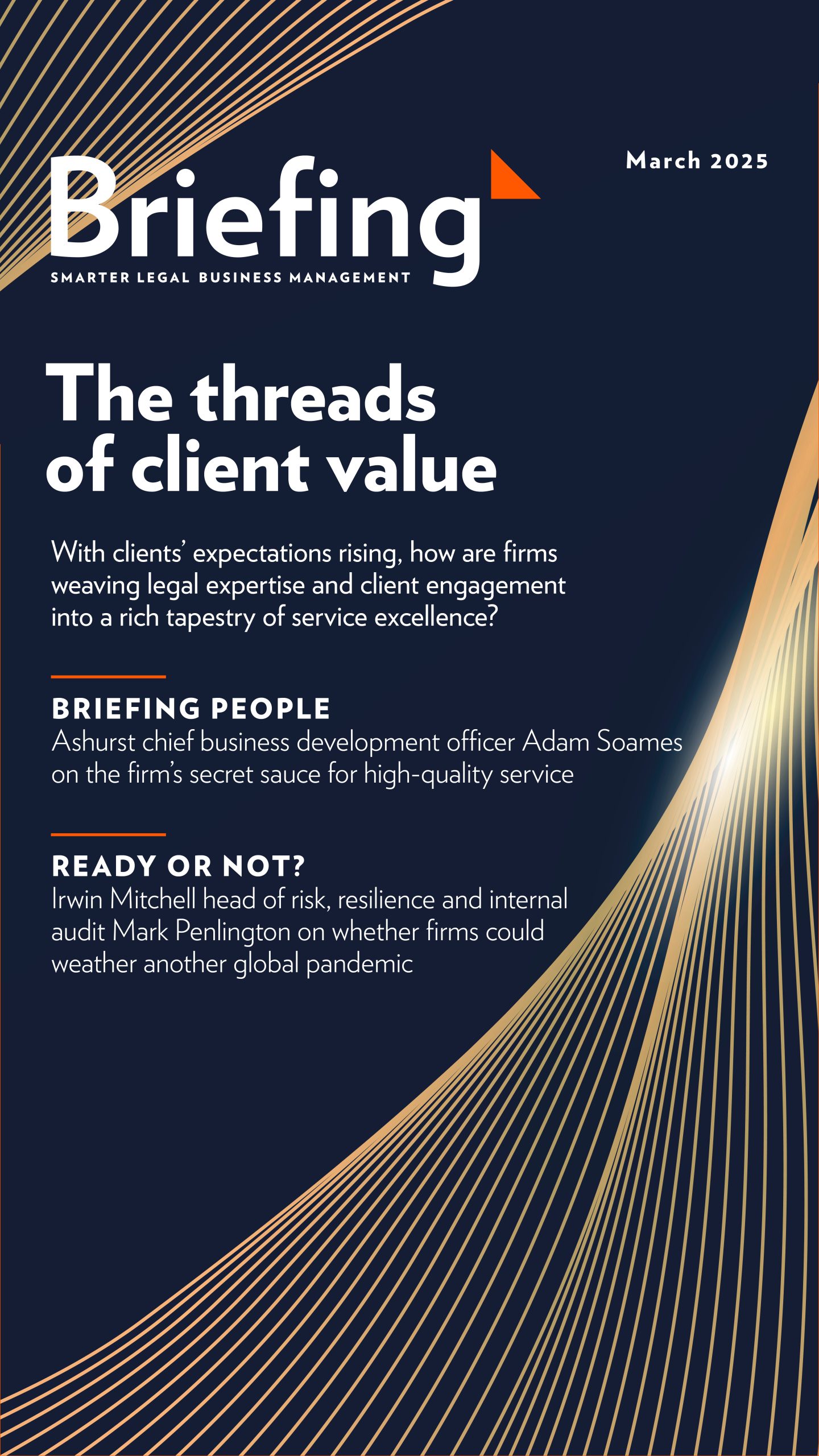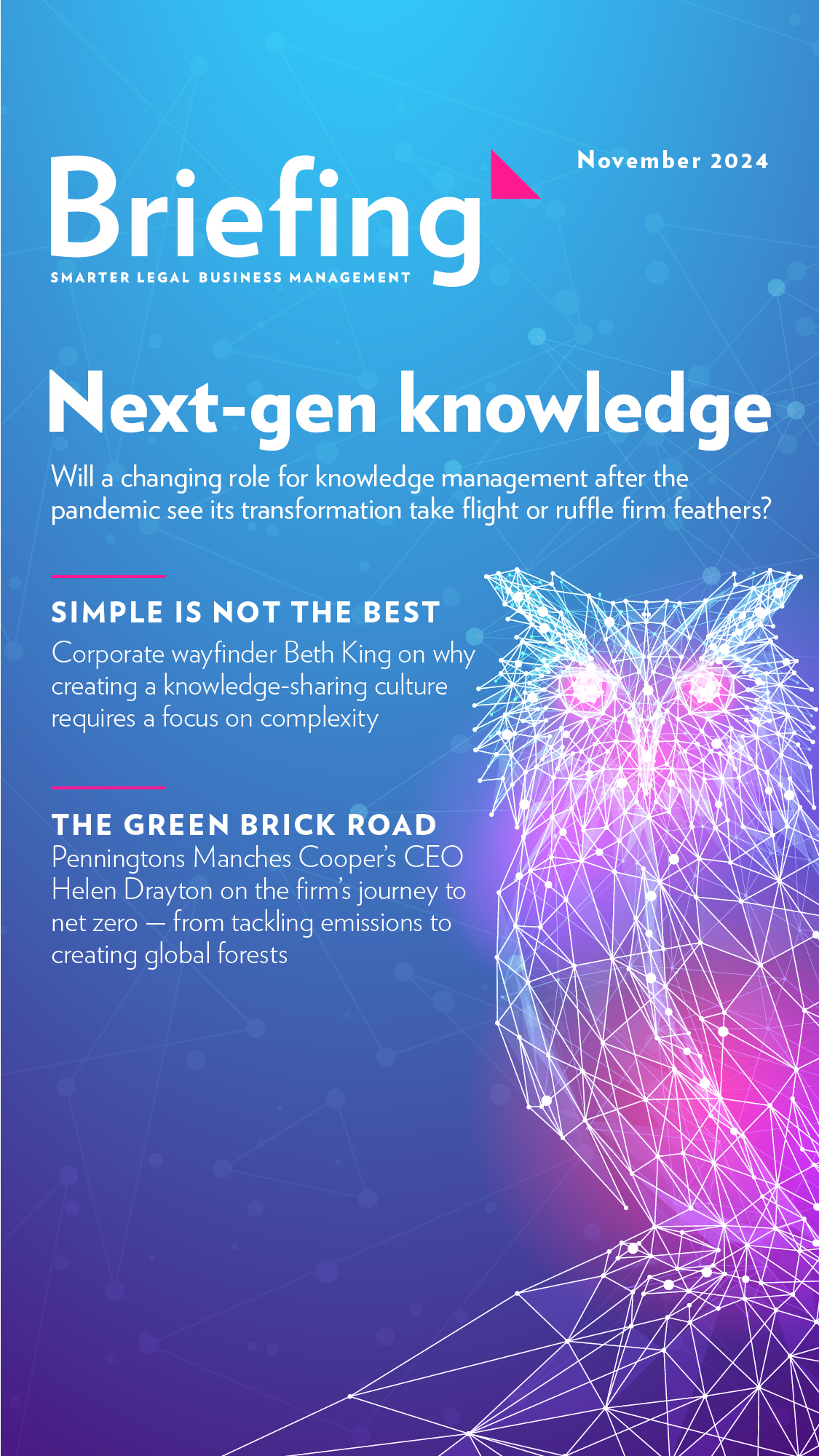doing disruption
It’s sometimes said the race to innovate legal services has turned disruption into the ‘new normal’, but is it yet normalised enough to be part of law firm culture? Has the innovation in client experience transformed how law firms operate more generally, and can they turn their investment into sustainable competitive advantage?
Early explorers undoubtedly enjoyed a first-mover advantage, as they offered genuine differentiation – something ‘new’. But is that advantage sustainable, even for them? Is disruption in itself enough to stand out, or could there also be benefit in holding back a little to learn lessons from the pioneers?
Service innovation isn’t all about new technology – and where it is, it should really be an enabler, rather than the end goal, of an improvement.
Either way, most larger firms now have innovation teams embedded in or tapping up the BD, KM or IT function. In many cases, they recruit new professionals with legal tech, project management or strategy backgrounds, to work alongside partner-led committees. However, product development and other process innovation often still takes place away from the day-to-day of the lawyering – and although individual partners might be very aware of the key features of a product or service, tech solutions can be very hard to embed across the business. Meanwhile, a firm needs to incubate the right mindset for a genuine culture of innovation to flourish – which can take some time, and plenty of hard work, in any organisation.
Of course, firms also need to talk to clients about what they want from any disruption, but in some cases clients themselves may not know everything that might be possible to improve the service they’re getting. The only way to meet that is fully proactive collaboration across the relationship, gathering information and asking the right questions.
Service innovation isn’t all about using new technology – and where it is, it should really be an enabler, rather than the end goal, of an improvement. Nor is innovation always terribly disruptive. Even something that seems to be at the ‘low tech’ end of the spectrum – making some operational basics more efficient – can be transformative; perhaps an initiative such as a more scientific work-allocation process or more consistency in document review, for example. And a new way of collaborating – in internal teams or with clients – is unlikely to be a wasted endeavour. I’d just highlight that in my experience, if a new initiative first ‘bubbles up’ within one area, rather than being centrally rolled out from on high, it can be a change management win and gain greater long-term traction as a result.
However innovation takes place at your firm, the way it’s happening there and elsewhere shouldn’t be ignored. Clients are disrupting the market for themselves, as well as buying into that of challenger ‘NewLaw’ brands. Innovation is a competitive risk factor, and firms that unquestioningly fall back on the practice of business-as-usual should ask themselves if it’s still the best option.
This article can be found in Briefing’s March magazine: Take on the system.
Brand new alternative
Under pressure from clients to reduce legal spend, many firms are looking at how they deliver legal services in new ways to maintain profitability and competitive advantage – but what impact does this have on a firm’s brand? Is it possible to be well positioned for big ticket work, and also offer commoditised products?
Innovation can be as simple as implementing a basic system or automation software, but it’s the firm that creates the ‘master platform’ that holds real competitive advantage.
At either end of this spectrum, we know that multi-functional teams can really drive client service forwards. Product developers, pitch teams, sector specialists, client managers, knowhow, finance, and relationship partners – all collaborating to create client-centric operating platforms – shape the client experience and build better, more cohesive relationships.
It could also be argued the Big Four use consulting work as a discovery phase to identify sales opportunities for their product team colleagues to pursue. However, an over-reliance on technological solutions might result in the human element of professional services taking a back seat, limiting opportunity to truly partner with the client to achieve their business objectives.
Therefore, understanding the client need is key when refining delivery models. But it also yields fruit. Deep sector knowledge has enabled firms to ‘build kit’ for industries rather than individual clients – meaning these products can become a new revenue source. Earlier in 2018, Pinsent Masons sold its digital compliance subsidiary to Dow Jones, demonstrating just one possible pathway of investment in alternative delivery models.
On the other hand, evaluating success using short-term metrics and aggressive sales targets is dangerous and potentially shifts focus from business improvement. And are delivery models following the path of value-added services? Over time, what was once a genuine differentiator can become business as usual, so the pressure is on for firms to be viewed as real leaders in this field.
Finally, we should remember that much of what law firms consider ‘low value’ work (time intensive, low revenue) is actually business-critical to the client. Discussing what value means to clients provides an opportunity for firms to think about ‘behavioural’ rather than ‘transactional’ branding, and to position the firm’s commerciality as its differentiator. Game-changing acquisitions such as Clifford Chance and Carillion, or the recent EY Riverview Law deal, certainly demonstrate a general appetite for disruption, and the market can use such developments to contextualise the benefits of alternative delivery models. However, robust and consistent messaging has to be developed to prevent new brand investments from cannibalising the core.There is certainly opportunity for firms that manage this feat. Clients’ legal departments face growing demands from their boards to innovate to reduce legal spend, but they may have little resource to invest in developing in-house systems. Innovation can be as simple as implementing a basic system or automation software, but it’s the firm that creates the ‘master platform’ that holds real competitive advantage.
This article originates from Briefing September 2018: Let’s talk shop










